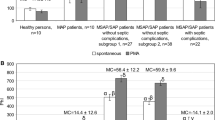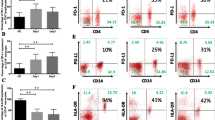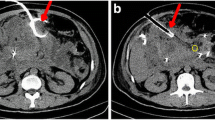Abstract
Determination of the prognosis in acute cases of pancreatitis, particularly in its serious and necrotizing form, still presents problems. Patients require intensive care and suffer from severe septic complications that do not correlate with pancreatic enzyme levels (amylase lipase). Method. Thirty-one patients with acute pancreatitis were examined: group 1 — necrotizing pancreatitis (lethal outcome n=7); group 2 — necrotizing pancreatitis (surviving n=12); group 3 edematous pancreatitis (surviving n=12). For 11 consecutive days after admission to a clinical ward, flow cytometric check-ups were carried out daily on all patients. The antigen-presenting system HLA-DR antigen expression on monocytes and C-reactive protein were examined. Results. When groups 1 and 2 were compared with group 3, HLA-DR values on monocytes were significantly different following the third day after admission (P<0.01). Comparison of groups 1 and 2 were significant from the third day of observation (P<0.001). During all 11 days of observation, patients in group 1 remained in immune paralysis (HLA-DR expression on monocytes CD 14+DR+ 20% antigen density). All of these patients had infected necroses. Patients in group 2 overcame their immune paralysis. HLA-DR depression of monocytes and a long-standing high C-reactive protein level are almost certain predictors of a fatal outcome in cases with severe pancreatitis. A routine passage cytometric check/FACS to determine the activity of monocytes (HLA-DR) is of prognostic significance.
Zusammenfassung
Die Bestimmung der Prognose bei Patienten mit akuter Pankreatitis ist ein aktuelles Problem. Durch die Einführung der Durchflußzytometrie (FACS-Analyse) in den klinischen Alltag ist eine routinemäßige immunologische Statusbestimmung möglich. Problem: Über immunologische Veränderungen im Verlauf einer akuten Pankreatitis ist wenig bekannt. Welche Rolle spielt z. B. das Monozyten-Makrophagen-System bei der akuten Pankreatitis, und haben diese Reaktionen eine klinische Relevanz. Methode: 31 Patienten mit der Diagnose akute Pankreatitis wurden erfaßt: Gruppe 1: schwere nekrotisierende Pankreatitis (letaler Ausgang n=7), Gruppe 2: schwere nekrotisierende Pankreatitis (Überlebende n=12) und Gruppe 3 milde ödematöse Pankreatitis (Überlebende n=12). An 11 aufeinanderfolgenden Tagen nach stationärer Aufnahme wurden tägliche durchflußzytometrische Immunphänotypisierungen durchgeführt. Für jeden Untersuchungstag wurden die Mittelwerte für die einzelnen Gruppen gebildet. Die Bestimmung des statistischen Unterschieds der Signifikanzen erfolgte mit dem t-Test (Bonferoni korrigiert). Ergebnisse: Die Untersuchungen konnten zeigen, daß die verminderte HLA-DR Expression auf Monozyten, als ein Ergebnis der Immunparalyse, bei Patienten der Gruppe 3 nur von kurzer Dauer ist. Der Unterschied zwischen Patienten der Gruppe 3 und den Patienten der Gruppen 1 und 2 ist signifikant ab dem 3. Tag (p<0,001). Der Vergleich zwischen Gruppe 1 und 2 zeigt einen signifikanten Unterschied ab dem 7. Tag nach Aufnahme (p<0,005). Während der gesamten Beobachtungsdauer von 11 Tagen verblieben alle Patienten der Gruppe 1 im Stadium der Immunparalyse (HLA-DR auf Monozyten CD14+DR+<20% Antigendichte). Diese Patienten hatten infizierte Nekrosen. Patienten der Gruppe 2 konnten die HLA-DR-Depression überwinden. Nur 3 Patienten der Gruppe 2 (25%) hatten infizierte Nekrosen. Eine andauernde HLA-DR-Depression auf Monozyten und ein konstant hoher CRP-Spiegel sind ein sicheres Zeichen für einen letalen Ausgang bei Patienten mit schwerer Pankreatitis. Die routinemäßige FACS-Analyse zur Bestimmung der Monozytenaktivität hat eine prognostische Bedeutung.
Similar content being viewed by others
Literatur
Appel SH, Wellhausen SR, Mongomery R, DeWeese RC, Polk HC (1989) Experimental and clinical significance of endotoxin-dependent HLA-DR expression on monocytes. J Surg Res 47: 39–44
Baehr R von, Lohmann T, Heym S, Reinke P, Tausch W, Volk HD (1990) Immunparalyse bei Septikämien-Labordiagnostiischer Nachweis und klinische Konsequenzen. Z Klin Med 45: 1133–1137
Barthlen W, Miethke T, Bartels H, Stadler H, Wagner H, Siewert JR (1994) Prognostische Aussagekraft der Monozyten-HLA-DR-Antigen-Expression bei abdominalchirurgischen Patienten. Langenbecks Arch [Suppl]379:265–270
Beger HG, Uhl W (1993) Operative management of acute pancreatitis. In: Trede M, Carter DC (eds) Surgery of the pancreas. Churchill Livingstone, Edinburgh London New York, pp 233–243
Bradley EL III (1993) A clinically based classification system for acute pancreatitis-summary of the International symposium on acute pancreatitis. Atlanta, GA, September 11 Through 13, 1992. Arch Surg 128: 586–590
Cheadle W, Hershman M, Wellhausen SR, Polk HC (1991) HLA-DR antigen expression on peripheral blood monocytes correlates with surgical infection. Am Surg 161: 639–645
Curley PJ, McMahon MJ, Lancaster F, Banks RE, Barclay GR, Shefta J, Boylston AW, Whicher JT (1993) Reduction in circulating levels of CD4-positive lymphocytes in acute pancreatitis: relationship to endotoxin, interleukin 6 and disease severty. Br J Surg 80:1312–1315
Döcke WD, Syrbe U, Meinecke A, Platzer C, Makki A, Asadullah K, Klug C, Zuckermann H, Reinke P, Brunner H, Baehr R von, Volk HD (1994) Improvement of monocyte function-A, new therapeutic approach? In: Reinhart K, Eyrich K, Sprung C (eds) Sepsis-update. Intensive Care Med 18:473–488
Heggers JP, Robson MC, Kucan JD (1984) Skin testing: a valuable predictor in thermal injury. Arch Surg 199:49–52
Hershman MJ, Cheadle WG, Wellhausen SR, Davidson PF, Polk HC (1990) Monocyte HLA-DR antigen expression characterizes clinical outcome in the trauma patient. Br J Surg 77:204–207
Miller CL, Baker CB (1979) Changes in lymphocyte activity after thermal injury: the role of suppressor cells. J Clin Invest 63:202–210
Polk HC (1993) Monocyte expression of class 11 antigens. Br J Surg 80:138–140
Rapaport FT, Converse JM, Horn L (1964) Altered reactivity to skin homografts in severe thermal injury. Ann Surg 159: 390–394
Richter A, Nebe TH, Hagmüller E, Schwall G, Trede M (1994) HLA-DR examination of progress in cases of acute pancreatitis to determine prognosis. Br J Surg [Suppl] 81: 109–110
Sakai H, Daniels JC, Lewis SR (1972) Reversible alterations of nucleid acid synthesis in lymphocytes after thermal burns. J Reticuloendothelial Sci 11: 19–28
Stein MD, Gamble DN, Klimper KD (1984) Natural killer cell defects resulting from thermal injury. Cell Immunol 86: 551–556
Susuki F, Pollard RB (1982) Alterations of interferon production in a mouse model of thermal injury. J Immunol 129:1806–1810
Volk HD, Lohmann T, Heym St, Ruppe U, Tausch W, Zuckermann B, Klug P, Thieme M, Döcke WD, Baehr R von (1992) Association between monocytec function and clinical outcome of sepsis. Microbiologist 3:20–26
Author information
Authors and Affiliations
Rights and permissions
About this article
Cite this article
Richter, A., Nebe, T., Kattermann, R. et al. Immunparalyse bei akuter Pankreatitis —HLA-DR-Antigen-Expression auf Monozyten CD14+DR+ . Langenbecks Arch Chir 381, 38–41 (1996). https://doi.org/10.1007/BF00184253
Received:
Issue Date:
DOI: https://doi.org/10.1007/BF00184253




